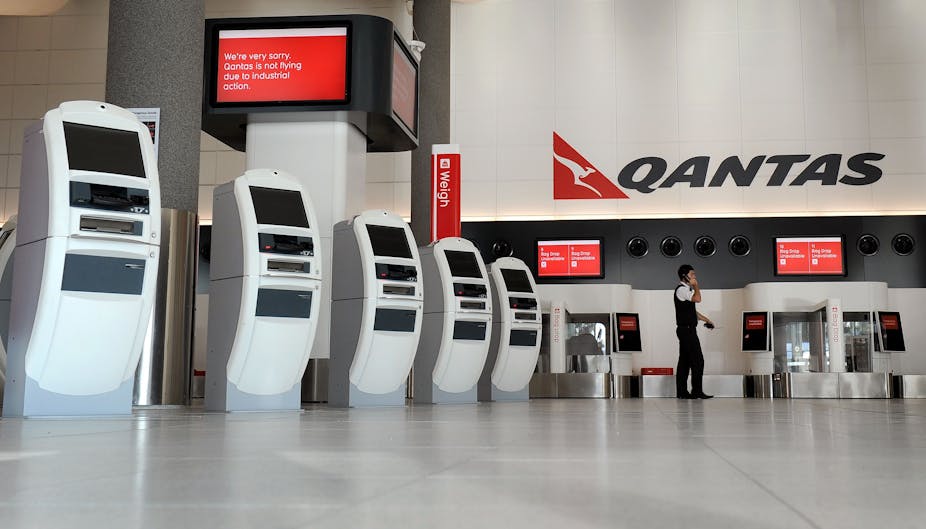Qantas planes are set to return to the air today after Fairwork Australia ruled to terminate an industrial dispute that grounded the airline over the weekend.
The extraordinary action on Saturday by Qantas chief executive Alan Joyce to ground the planes affected more than 68,000 passengers worldwide. Qantas and the three unions involved will now have 21 days to resolve their differences through mediation.
Roy Green, Dean of UTS Business School at the University of Technology, Sydney looks at how it came to this and what now for Qantas.
Read the full FWA decision here
Over the past two decades, Qantas has grappled, more successfully than most “legacy” airlines, with the challenge of moving from state ownership to a commercial operation.
Among its strategic initiatives was the creation of Jetstar to enable the development of Qantas as a premium brand through market segmentation.
It was largely the success of Jetstar that catapulted Alan Joyce to the leadership of Qantas over his rival John Borghetti, who has gone on to reposition Virgin as a formidable competitor in the premium brand space.
Now, potentially squeezed between Virgin’s aggressive campaign for the premium traveller and lower cost Asian competitors and with an ageing aircraft fleet compounded by delays in the delivery of new planes, Qantas has been forced to make a further strategic reassessment.
Changing business model
It seems to have decided to follow through the logic of the Jetstar model on a global scale, even, if it proves necessary, at the longer term expense of the Qantas brand.
This is a risky approach but one worthy of discussion and debate, and certainly one that should include its employees, shareholders and indeed the Australian government under the terms of the Qantas Sale Act.
So here is the problem. The Qantas board and senior management have made this decision unilaterally on the basis that no one else could be trusted to participate, and possibly emerge from a broader dialogue with different conclusions.
But the point is that corporate leaders do have a choice in devising and implementing new and untested business models.
They can behave as Qantas has done, with an extraordinarily insensitive combination of job losses, a 70% pay rise for the CEO and now a full-scale industrial lock-out.
Or they can pursue a more inclusive approach, drawing on the talent and dedication of their workforce, as well as a residual but still robust loyalty to an iconic brand.
Lock out

There are precedents for both approaches. The current lock-out most obviously recalls the action of Patrick Stevedores in the 1998 ports confrontation, and also the tactics sometimes employed in the adversarial industrial relations of the mining industry, such as Rio Tinto’s 1995 Weipa dispute.
The similarity with the Qantas situation is that these disputes had less to do with productivity than the blunting of union power, but an important difference is that a major Australian global brand and its associated services were not at risk.
A closer analogy, and one which might be better appreciated by Alan Joyce, was the Irish Ferries attempt in 2004 to replace its Irish crews with cheaper labour, avoiding its European Union obligations by resorting to maritime law.
Unfortunately for the company, its manoeuvre coincided with the Irish government’s much publicised National Forum on the Workplace of the Future, which placed great store on a “partnership” approach to productivity improvement and organisational change, and it also met with fierce criticism by then Taoiseach (Prime Minister) Bertie Ahern and a trade union day of protest which involved 100,000 people across Ireland. The dispute was ultimately resolved by the Irish Labour Relations Commission.
Coming when it did, the Irish Ferries dispute served to highlight the value of alternative, more cooperative approaches to the development of innovative business models and capabilities and the management of change.
Partnership approach
This approach also has its precedents, including the “management-employee partnership” that has underpinned the competitive success of Southwest Airlines in the United States.
Such organisations have what in the words of Booz & Co’s new Global Innovation 1000 study are the elements of a “truly innovative company”: “a focused innovation strategy, a winning overall business strategy, deep customer insight, great talent, and the right set of capabilities to achieve successful execution”.

More important than any of the individual elements, according to this study, “is the role played by corporate culture – the organisation’s self-sustaining patterns of behaving, feeling, thinking and believing – in tying them all together”.
The data shows that “companies with unsupportive cultures and poor strategic alignment significantly underperform their competitors”.
Destroying the brand
Qantas management will need to ask themselves how a “truly innovative company” with a strong, inclusive corporate culture will emerge by recreating the winner-takes-all conflict between Ryanair and Aer Lingus within its own stable of brands.
Because everyone else is already asking whether there is anything to be gained by blaming unions for an unconstructive attitude when the “new spirit” of Qantas seems oblivious to the destruction of its own and Australia’s most prominent brand.

